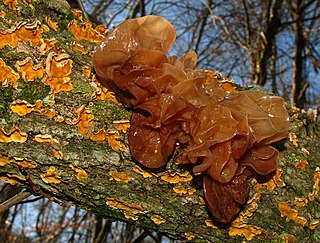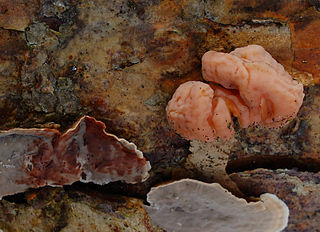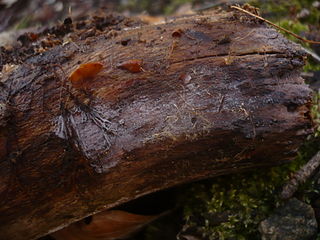
Exidia is a genus of fungi in the family Auriculariaceae. The species are saprotrophic, occurring in attached or recently fallen dead wood, and produce gelatinous basidiocarps. The fruit bodies are diverse, pustular, lobed, button-shaped or cup-shaped. Several species, including the type species Exidia glandulosa, have sterile pegs or pimples on their spore-bearing surface. The genus has a cosmopolitan distribution and around 20 species are currently recognized worldwide. Initial molecular research indicates the genus is artificial.

Sebacina is a genus of fungi in the family Sebacinaceae. Its species are mycorrhizal, forming a range of associations with trees and other plants. Basidiocarps are produced on soil and litter, sometimes partly encrusting stems of living plants. The fruit bodies are cartilaginous to rubbery-gelatinous and variously effused (corticioid) to coral-shaped (clavarioid). The genus has a cosmopolitan distribution.

Myxarium nucleatum is a species of fungus in the family Hyaloriaceae. In the UK, it has been given the recommended English name of crystal brain. The fruit bodies are watery white, pustular or lobed, and gelatinous with small, white, mineral inclusions visible to the naked eye. It is a common, wood-rotting species in Europe, typically growing on dead attached or fallen branches of broadleaf trees. It is currently not clear whether collections from North America and elsewhere represent the same species.

Phaeotremella is a genus of fungi in the family Phaeotremellaceae. All Phaeotremella species are parasites of other fungi and produce anamorphic yeast states. Basidiocarps, when produced, are gelatinous and are colloquially classed among the "jelly fungi". Fifteen or so species of Phaeotremella are currently recognized worldwide. Tremella sanguinea, shown to be a Phaeotremella species by DNA sequencing, is cultivated in China as an ingredient in traditional Chinese medicine.

Phaeotremella frondosa is a species of fungus in the family Phaeotremellaceae producing brownish, frondose, gelatinous basidiocarps. It is widespread in north temperate regions, and is parasitic on other species of fungi that grow on dead attached and recently fallen branches of broadleaf trees.

Naematelia aurantia is a species of fungus producing yellow, frondose, gelatinous basidiocarps. It is widespread in north temperate regions and is parasitic on another species of fungus that grows on dead attached and recently fallen branches of broadleaf trees. It is commonly called golden ear in North America.

Naematelia encephala is a species of fungus producing pink, brain-like, gelatinous basidiocarps. It is widespread in north temperate regions and is parasitic on another species of fungus that grows on dead attached and recently fallen branches of conifers. In the UK, its recommended English name is conifer brain.

Tulasnella violea is a species of fungus in the order Cantharellales. Basidiocarps are typically smooth, ceraceous (waxy), violet-pink or lilaceous to grey, and occur on the underside of fallen branches and logs. It is one of the more conspicuous Tulasnella species and appears to be distributed worldwide. Though normally saprotrophic, Tulasnella violea can form a mycorrhizal association with orchids.
Cystobasidium fimetarium is a species of fungus in the order Cystobasidiales. It is a fungal parasite forming small gelatinous basidiocarps on various ascomycetous fungi on dung. Microscopically, it has auricularioid basidia producing basidiospores that germinate by budding off yeast cells. The species is known from Europe and North America.
Phaeotremella fimbriata is a species of fungus in the family Phaeotremellaceae. It produces blackish, frondose, gelatinous basidiocarps and is parasitic on the mycelium of Stereum rugosum, a fungus that grows on dead attached and recently fallen branches of broad-leaved trees. It is widespread in northern Europe. Prior to 2017, the species was generally considered a synonym of Tremella foliacea, but this latter species is restricted to conifers. Phaeotremella frondosa is a similar-looking but paler, brown species on broad-leaved trees and occurs in North America as well as Europe.

Tremella iduensis is a species of fungus in the family Tremellaceae. It produces yellow, cornute-frondose, gelatinous basidiocarps and is parasitic on other fungi, probably species of Hypoxylon on dead attached and recently fallen branches of broad-leaved trees. It has been recorded from Japan and China. Tremella flava, described from Taiwan, may be a synonym.

Phaeotremella mycophaga is a species of fungus in the family Phaeotremellaceae. It produces small, pustular, gelatinous basidiocarps on the hymenium of the corticioid fungi Aleurodiscus amorphus and A. grantii on conifers.
Tremella dysenterica is a species of fungus in the family Tremellaceae. It produces bright yellow, red-spotted, lobed to subfrondose, gelatinous basidiocarps and is parasitic on other fungi on dead branches of broad-leaved trees. It was originally described from Brazil and has been recorded elsewhere in the neotropics and in Africa.
Tremella olens is a species of fungus in the family Tremellaceae. It produces soft, whitish, lobed to frondose, gelatinous basidiocarps and is parasitic on other fungi on dead branches of broad-leaved trees. It was originally described from Tasmania.
Tremella roseolutescens is a species of fungus in the family Tremellaceae. It produces rose-pink to salmon, pustular, gelatinous basidiocarps and is parasitic on other fungi on dead attached branches of broad-leaved trees. It was originally described from Costa Rica.
Tremella erythrina is a species of fungus in the family Tremellaceae. It produces orange to red, lobate to foliaceous, gelatinous basidiocarps and is parasitic on other fungi on wood of broad-leaved trees. It was originally described from China.
Tremella coffeicolor is a species of fungus in the family Tremellaceae. It produces brown, lobed to foliaceous, gelatinous basidiocarps and is parasitic on other fungi on dead branches of broad-leaved trees. It was originally described from Bermuda, where it was collected as part of the Challenger expedition.
Tremella exigua is a species of fungus in the family Tremellaceae. It produces small, dark, pustular, gelatinous basidiocarps and is parasitic on pyrenomycetous fungi on dead branches of trees and shrubs. It was originally described from France.
Tremella mesenterella is a species of fungus in the family Tremellaceae. It produces yellowish to reddish brown, foliose, gelatinous basidiocarps and is parasitic on corticioid fungi on dead branches of broadleaf trees and shrubs. It was originally described from Canada.
Phaeotremella translucens is a species of fungus in the family Phaeotremellaceae. It produces small, pustular, gelatinous basidiocarps and is parasitic on ascocarps of Lophodermium species on decaying pine needles. It was originally described from Scotland.









